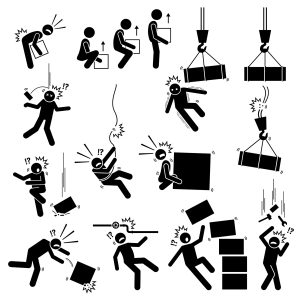This guide examines some common industries and jobs at risk of manual handling injuries. We will first examine the different types of manual handling injuries that could be suffered in the workplace before examining common industries that may be exposed to manual handling risks.
We also explain the duty of care owed by employers with regard to manual handling activities, referring to relevant laws and the steps employers need to take to uphold their legal requirements to protect their workforce.
Towards the end of this guide we examine the No Win No Fee agreement offered by our panel of expert personal injury solicitors, highlighting how potential claimants can benefit when instructing a solicitor to represent them under such a contract.
To ask any questions that may arise when reading this guide or for a free consultation concerning your potential manual handling injury claim, you can speak to an advisor today. Our dedicated and highly experienced team are available 24/7 using the contact information provided here:
- Phone on 020 8050 2736.
- Fill out our claim online form to organise a callback.
- Ask a question using the live chat feature at the bottom of your screen.
Select A Section
- What Are Manual Handling Injuries?
- What Are Common Industries And Jobs At Risk Of Manual Handling Injuries?
- How Can Your Employer Prevent You From Experiencing Manual Handling Injuries?
- Find Out How We Can Help With Manual Handling Claims
- More Resources About Preventing Accidents At Jobs At Risk Of Manual Handling Injuries
What Are Manual Handling Injuries?
Manual handling injuries are injuries that arise due to improper manual handling practices. The Health and Safety Executive (HSE), Britain’s regulator for workplace health and safety, define manual handling as the use of bodily force to transport or support a load. If a manual handling task isn’t carried out in a manner that is safe, various injuries could occur.
Some examples of injuries that could be suffered in manual handling incidents include:
- Work related musculoskeletal disorders.
- Injuries to the shoulders and arms, such as dislocations.
- Hand and foot injuries, such as breaks and fractures.
- Back injuries, such as soft tissue injuries.
You can learn more about potential manual handling injuries that could be suffered in the workplace by speaking to one of our dedicated advisors. The team are available 24/7 using the details given above.
What Are Common Industries And Jobs At Risk Of Manual Handling Injuries?
The HSE also provide statistics on employee work-related injuries reported by employers under the Reporting of Injuries, Diseases and Danegour Occurrences Regulations 2013 (RIDDOR). Employers are required to report certain workplace accidents and injuries to the HSE under RIDDOR.
The HSE states that in 2022/2023 there were 10,230 non-fatal employee injuries reported under RIDDOR that were caused by handling, lifting or carrying. Of these reports, some of the most common industries that experienced these manual handling injuries included:
- Human health and social work activities: 2,161
- Manufacturing: 1,983.
- Transportation and storage: 1,613.
- Wholesale and retail trade, repair of motor vehicles and motorcycles: 1,275.
- Construction: 663.
The next few sections will examine how employers can prevent manual handling accidents across different injuries, as well as explain how failing to take these measures could result in employees suffering a workplace injury.
How Can Your Employer Prevent You From Experiencing Manual Handling Injuries?
If you conduct manual handling operations as part of your work activities, your employer should ensure these activities are conducted safely and in accordance with relevant legislation.
The Health and Safety At Work etc. Act 1974 establishes a general duty of care for all employers to uphold. Per their duty of care, employers must take reasonable steps to ensure the safety of their employees while they are in the workplace and performing their duties, such as manual handling tasks.
Manual Handling Regulations 1992
The Manual Handling Operations Regulations 1992 provides guidance to those who oversee manual handling operations, such as employers, on how to assess, avoid and reduce the risk of injury from manual handling.
The HSE provide guidance regarding manual handling activities and how to reduce the risk of injuries from such tasks. These include:
- Avoid hazardous manual handling activities: If manual handling tasks can be avoided, they should be. This can be done by redesigning the task to avoid moving the load. Manual handling can also be avoided through automation (conveyor belts and chutes) or mechanisation (forklifts, electric hoists and pallet trolleys).
- Risk assessing manual handling tasks that cannot be avoided: Employers should assess the load, task, individual capability and working environment for any manual handling tasks that cannot be avoided. This could include assessing how far the load is being carried or lifted, the postures adopted by those performing the task, and the nature of the load, such as whether it is slippery or sharp.
- Reduce the risk of injury: Where manual handling cannot be avoided, steps should be taken to reduce the risk of injury. Large loads can be broken up into smaller loads, and modifications can be made to the working environment to avoid the need for twisting movements or lifting objects above shoulder height.
- Ensure workers have received appropriate manual handling training: Workers should receive adequate manual handling training on proper lifting techniques and the use of mechanical aids. Workers should also be informed of the risk factors and how injuries can happen. Periodic reviews of procedures should also be conducted.
In the next few sections, we will focus on specific industries and jobs at risk of manual handling injuries and the steps that could be taken to prevent them.
Construction and Building Sites
Construction sites are inherently dangerous due to the heavy loads, moving vehicles and use of machinery and power tools. There are various ways that a construction worker could suffer a manual handling injury. For example, if they were not provided with adequate personal protective equipment (PPE).
Examples of PPE for manual handling on a construction site could include:
- Protective footwear not only provides grip for uneven and loose surfaces but also provides protection for your feet from dropped objects.
- Gloves can help with gripping heavy or awkward loads, but also prevent hand injuries such as cuts and bruising.
- Eye protection keeps construction worker’s vision safe if they’re carrying dusty or hazardous materials.
Healthcare and Nursing
Those working in healthcare and nursing engage in manual handling frequently. Moving medical equipment and beds, laundry and moving patients all consitute manual handling tasks.
These tasks, especially lifting elderly, disabled or otherwise less mobile patients, present a real risk of injury if proper training and supervision are not provided. If no manual handling training or inadequate instruction is provided, various injuries could be caused due to improper lifting techniques or attempts to carry heavy loads.
Manual handling training should cover the following aspects:
- Identifying risk factors, such as whether a lifting task requires two workers to perform it safely.
- Proper lifting techniques to avoid injuries and carry loads safely.
- The safe use of mechanical aids, automated procedures and how to report faults in the equipment.
Employers should ensure that all staff have received sufficient training and have had their competency confirmed before instructing them to perform manual handling tasks. Periodic reviews and additional training should also be carried out to ensure workers are conducting manual handling tasks safely.
Retail and Warehousing
Retail and warehousing jobs also involve extensive manual handling tasks. Goods need to be moved from storage to the point of sale almost every day. As these jobs involve carrying and lifting objects, employers should be aware of any potential risk factors that could result in a warehouse accident and injuries.
This means carrying out a thorough risk assessment and addressing any potential hazards they come across. When performing a risk assessment, employers could assess the following:
- The size and weight of loads. Heavy objects should not be carried long distances, and large objects should be carried by multiple people.
- The working environment should be organised to avoid manual handling as far as possible or reduce the risk of unavoidable tasks. Automation and mechanical aids should be employed, and floors should be even and free from trip hazards.
- Frequent manual handling operations can result in workers developing RSI. This can be avoided by rotating workers onto different tasks and ensuring breaks are provided.
- Some workers may be more capable than others. For example, a worker who has back problems should not be conducting strenuous manual handling activities.
You can learn more about the jobs at risk of manual handling injuries and the steps your employer should take to help protect you by speaking to our advisors. The team can also provide a free assessment of your eligibility to claim compensation for manual handling accidents.
Find Out How We Can Help With Manual Handling Claims
As aforementioned, your employer owes you a duty of care while you are working. If you have suffered an injury in an accident at work, you may be eligible to make a manual handling claim. However, your case will need to meet the following criteria:
- A duty of care was owed to you.
- Your employer breached this duty of care.
- You suffered an injury as a result of this breach.
You can contact our advisors to discuss the eligibility of your case. If they decide you have a valid case, they may connect you with one of the personal injury solicitors on our panel, who could offer their services to you under a Conditional Fee Agreement (CFA).
This is a specific kind of No Win No Fee contract that comes with various benefits. For example, there will be no fee to pay upfront for the solicitor to start working on the claim, or during the actual claims process. Additionally, you will not have to pay a service fee should the claim fail.
Your No Win No Fee solicitor will deduct a success fee from your compensation should your claim be a success. There is a legal cap in place for the percentage that can be taken as this fee. Additionally, prior to the claiming process, you and the solicitor will agree on this percentage.
Contact Our Team
If you have any further questions regarding jobs at risk of manual handling injuries, or to see whether you may have a valid personal injury claim, you can contact our team of advisors. Contact our advisors today if you have been injured in a manual handling accident to see whether one of the No Win No Fee solicitors on our panel could help you with claiming compensation:
- Call on 020 8050 2736
- Fill out our claim online form to arrange a callback.
- Ask a question using the live chat feature at the bottom of your screen.
More Resources About Preventing Accidents At Jobs At Risk Of Manual Handling Injuries
You can view some of our other guides regarding accident at work claims here:
- If you have suffered an arm injury in a construction accident, this guide discusses when you may be able to claim compensation.
- Improper manual handling techniques could result in a finger injury at work. This guide will help you find out more about claiming compensation.
- If you have sustained a back injury in a construction accident, you may be entitled to claim compensation. Read this guide for additional information.
You can also browse these external resources for additional information:
- This guidance from the NHS will explain how you can tell if you’ve broken a bone in an accident.
- You may be entitled to receive Statutory Sick Pay following an accident at work. Find out more with this government resource.
- HSE resource on getting help with manual handling risks for your business.
Thank you for reading our guide to common industries and jobs at risk of manual handling injuries. You can contact our advisors with any questions you may have, or to see whether you may have a valid accident at work claim if you suffered a manual handling injury.



